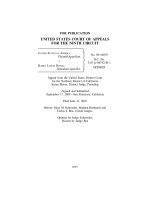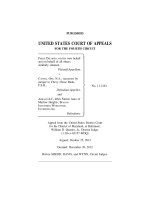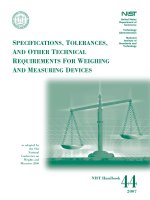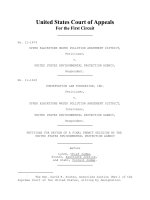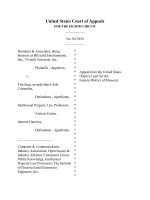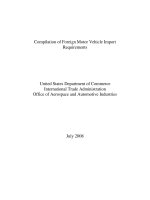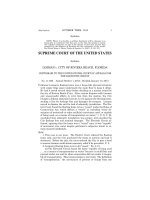United States Department of Agriculture Food Safety and Inspection Service, Office of Public Health Science
Bạn đang xem bản rút gọn của tài liệu. Xem và tải ngay bản đầy đủ của tài liệu tại đây (272.08 KB, 26 trang )
United States Department of Agriculture
Food Safety and Inspection Service, Office of Public Health Science
Page 1 of 26
CLG-AGON1.02
Title: Identification of Beta-Agonists by HPLC/MS/MS
Revision: 02
Replaces: CLG-AGON1.01
Effective: 08/27/2007
Contents
A.
INTRODUCTION ....................................................................................... 2
B.
EQUIPMENT ............................................................................................. 4
C.
REAGENTS AND SOLUTIONS ................................................................ 5
D.
STANDARDS ............................................................................................ 5
E.
SAMPLE PREPARATION ......................................................................... 7
F.
ANALYTICAL PROCEDURE..................................................................... 7
G.
IDENTIFICATION .................................................................................... 11
H.
SAFETY INFORMATION AND PRECAUTIONS..................................... 12
I.
QUALITY ASSURANCE PLAN ............................................................... 13
J.
WORKSHEET ......................................................................................... 15
K.
APPENDIX .............................................................................................. 18
L.
APPROVALS AND AUTHORITIES ......................................................... 26
United States Department of Agriculture
Food Safety and Inspection Service, Office of Public Health Science
Page 2 of 26
CLG-AGON1.02
Title: Identification of Beta-Agonists by HPLC/MS/MS
Revision: 02
A.
INTRODUCTION
1.
Theory
Replaces: CLG-AGON1.01
Effective: 08/27/2007
Free residues of clenbuterol, salbutamol, cimaterol, zilpaterol, and ractopamine are
extracted from retinal, liver, or muscle tissues with a mixture of acetonitrile, isopropanol,
sodium chloride, sodium sulfate, and magnesium sulfate. This extract is evaporated,
reconstituted in water, filtered, and analyzed by LC/MS/MS.
2.
Applicability
This method is applicable to identification of β-agonists in bovine retinal tissue (except
for zilpaterol); bovine, porcine, ovine, and caprine liver; and bovine and porcine muscle
at ≥ 3 ppb for clenbuterol, salbutamol, and cimaterol; ≥ 6 ppb for zilpaterol; and ≥ 21 ppb
for ractopamine.
3.
Structure
Note: For proposed fragmentation paths, see Appendix, K.3.
Clenbuterol Hydrochloride
Salbutamol
United States Department of Agriculture
Food Safety and Inspection Service, Office of Public Health Science
Page 3 of 26
CLG-AGON1.02
Title: Identification of Beta-Agonists by HPLC/MS/MS
Revision: 02
Cimaterol
Ractopamine HCl
Zilpaterol
Replaces: CLG-AGON1.01
Effective: 08/27/2007
United States Department of Agriculture
Food Safety and Inspection Service, Office of Public Health Science
Page 4 of 26
CLG-AGON1.02
Title: Identification of Beta-Agonists by HPLC/MS/MS
Revision: 02
B.
Replaces: CLG-AGON1.01
Effective: 08/27/2007
EQUIPMENT
Note: Equivalent apparatus may be substituted for the following:
1.
Apparatus
a.
Petri Dishes – disposable polystyrene, Optilux 100 x 20 mm, Cat. No. 1005,
Becton Dickinson.
b.
Scalpels – Fisherbrand single-use scalpel, Cat. No. 08-927-5D, Fisher, or Razor
Blades – Single edge safety razor, American Safety Razor Co.
c.
Cut Resistant Glove – Cat. No. FSIS-50, FSIS Beltsville Service Center, or Ansell
Polar Bear Glove, Cat. No. 19-058-952, Fisher.
d.
Waring commercial blender Model 51BL31.
e.
Tissuemizer – Polytron, Brinkmann Instruments Ltd.
f.
Top loading balance – 0.01 g sensitivity, PJ3600 DeltaRange, Mettler.
g.
Centrifuge tubes – 50 mL round bottom polyallomer with sealing caps, Cat. No.
3138-0050, Nalgene.
h.
Centrifuge tubes – 50 mL conical, disposable, polypropylene, with caps, Cat. No.
352098, Becton Dickinson.
i.
Micropipetters – Adjustable, 10 – 5000 µL, Eppendorf.
j.
Glass rods – 10 mm diameter by 25 cm length, fired and rounded at both ends.
k.
Vortex mixer – variable speed, Cat. No. S8223-1, American Scientific Products.
l.
Shaker – Horizontal flatbed, two speed, Cat. No. 511105, Eberbach.
m.
Centrifuge – International Equipment Company B-22M high speed with rotor 876
for 50 mL tubes, Cat. No. 20671-007, VWR Scientific.
n.
Syringeless filter device – Mini-UniPrep, 0.45 µm nylon, Cat. No.
UN203NPUNYL, Whatman.
o.
Evaporator – N-Evap, Organomation Associates Inc.
p.
Filter – 0.45 µm, nylon, acrodisc-13, Cat. No. 4551, Pall Gelman Sciences, Inc.
q.
Analytical balance – 0.0001 g sensitivity, AG204, Mettler.
r.
Volumetric flasks – 1L, 100 mL amber, 10 mL amber.
s.
HPLC mobile phase filtering and degassing apparatus – Microfiltration Assembly,
47 mm, Millipore.
t.
HPLC guard column - C18 Security Guard cartridge, 2.1 x 4 mm, 2 µm particles,
Cat. No. AJO-4286 and Security Guard kit, Cat. No. KJO-4282, Phenomenex.
u.
HPLC column - BetaMax Base, 2.1 x 100 mm, 5 µm particles, Cat. No. 95105-
United States Department of Agriculture
Food Safety and Inspection Service, Office of Public Health Science
Page 5 of 26
CLG-AGON1.02
Title: Identification of Beta-Agonists by HPLC/MS/MS
Revision: 02
Replaces: CLG-AGON1.01
Effective: 08/27/2007
102130, Thermo Hypersil.
2.
C.
Instrumentation
a.
Waters Alliance 2695 HPLC equipped with an autosampler.
b.
Waters Micromass Quattro micro API mass spectrometer.
REAGENTS AND SOLUTIONS
Note: Equivalent reagents / solutions may be substituted for the following.
1.
2.
Reagents
a.
Methanol (MeOH) – HPLC grade, Cat. No. 230-4, Burdick & Jackson.
b.
Acetonitrile (ACN) – HPLC grade, Cat. No. 015-4, Burdick & Jackson.
c.
Isopropanol (IPA) – HPLC grade, Cat. No. AH323-4, Burdick & Jackson.
d.
Sodium chloride (NaCl) – ACS reagent grade, Cat. No. S271-1, Fisher.
e.
Sodium sulfate (Na2SO4) – ACS reagent grade, Cat. No. 354250010, Acros
Organics.
f.
Magnesium sulfate (MgSO4) – anhydrous, minimum 99.5% purity, Cat. No.
M-7506, Sigma.
g.
Water – Deionized, HPLC grade, Millipore Rx system.
h.
Formic acid – Purity 98 - 100%, Cat. No. 27001, Riedel-de Haën.
Solutions
a.
Aqueous mobile phase (0.1% formic acid in water):
Pipet 1 mL of formic acid into a 1 L volumetric flask. Fill to volume with Millipore
water. Degas before use. Vacuum filter if desired through a 0.45 µm nylon filter.
D.
STANDARDS
1.
Source
a.
Clenbuterol HCl (CLEN) – approximately 95% pure, Cat. No. C-5423, Sigma
Chemical Co.
b.
Cimaterol (CIM) – Cat. No. 159757, MP Biochemicals Inc.
c.
Salbutamol (SAL) – approximately 95% pure, Cat. No. S-8260, Sigma Chemical
Co.
d.
Ractopamine HCl (RAC) – Elanco Animal Health.
e.
Zilpaterol (ZIL) – Intervet Inc.
United States Department of Agriculture
Food Safety and Inspection Service, Office of Public Health Science
Page 6 of 26
CLG-AGON1.02
Title: Identification of Beta-Agonists by HPLC/MS/MS
Revision: 02
2.
Replaces: CLG-AGON1.01
Effective: 08/27/2007
Preparation
Note: Adjust all standard weights for purity.
a.
CLEN, CIM, SAL and ZIL stock standards (~25 µg/mL):
Weigh ~2.5 mg of CLEN, CIM, SAL and ZIL into its own 100 mL amber
volumetric flask and bring to volume with methanol. Record the weight to 0.1 mg
and calculate the exact concentration. These standards are stable for 2 months
when stored in the refrigerator at 2 - 8 °C.
b.
RAC stock standard (~1 mg/mL):
Weigh ~10.0 mg into a 10 mL volumetric flask and dilute to volume with
methanol. Record the weight to 0.1 mg and calculate the exact concentration.
This standard is stable for 3 months when stored in the refrigerator at 2 - 8 °C.
c.
RAC intermediate standard (10 µg/mL):
Pipet ~100 µL (adjusted for the actual stock standard concentration) of the RAC
stock standard into a 10 mL volumetric flask and bring to volume with Millipore
water. This standard is stable for 1 month when stored in the refrigerator at
2 - 8 °C.
d.
Mixed intermediate standard A (250 ng/mL CLEN, CIM, SAL; 500 ng/mL ZIL;
1.75 μg/mL RAC):
Pipet ~100 µL (adjusted for the actual stock standard concentration) of the
CLEN, CIM, SAL stock standards, ~200 µL of the ZIL stock standard, and
~1.75 mL of the 10 µg/mL RAC intermediate standard into a 10 mL amber
volumetric flask and bring to volume with Millipore water. This standard is stable
for 1 month when stored in the refrigerator at 2 - 8 °C.
e.
Mixed intermediate standard B (50 ng/mL CLEN, CIM, SAL; 100 ng/mL ZIL;
0.35 μg/mL RAC):
Pipet 200 µL of the mixed intermediate standard A into an HPLC vial and add
800 µL Millipore water. This standard is stable for 1 month when stored in the
refrigerator at 2 - 8 °C.
f.
Mixed external standard (3 ng/mL CLEN, CIM, SAL; 6 ng/mL ZIL; 21 ng/mL
RAC):
Pipet 60 µL of mixed intermediate standard B and 940 µL of Millipore water into
an HPLC vial. This standard is stable for 1 month when stored in the refrigerator
at 2 - 8 °C.
United States Department of Agriculture
Food Safety and Inspection Service, Office of Public Health Science
Page 7 of 26
CLG-AGON1.02
Title: Identification of Beta-Agonists by HPLC/MS/MS
Revision: 02
Replaces: CLG-AGON1.01
E.
SAMPLE PREPARATION
1.
Retinal excision
Effective: 08/27/2007
a.
Eyeballs should be thawed at room temperature just enough so that the outside
tissues can be manipulated but the aqueous and vitreous humors are still frozen.
This takes about 45 to 60 minutes. The eyeball should not deform any
noticeable amount when squeezed.
b.
Incise the eyeball by slowly cutting across the cornea horizontally and vertically
with a scalpel or a razor blade, using whichever provides more control during the
cutting process. The length of the incisions should include the full width and
length of the cornea, and extend into the sclera to allow the eyeball to be evened.
Force the semi-frozen contents (aqueous and vitreous humors and lens) out of
the eyeball and retain (the eye contents may be discarded if retinal results are
negative for beta agonists).
Caution: To ensure minimal risk from BSE while performing the excision,
wear a cut resistant glove on the hand holding the eyeball, and safety
glasses or a face shield. Wash hands thoroughly after performing the
excision.
c.
Evert the eyeball, and scrape the choroid/PRE layer into a petri dish. This layer
is distinctive in bovine species due to its iridescent bluish-green metallic
coloration on black background. Include black filmy tissue emanating from the
optic nerve area (neural retina) if observed.
Note: Whole eyeballs can be stored at -20 ºC or lower for at least one year.
Extracted retinal tissue can be stored at -40 ºC or lower for one week (longer
results in dry tissue).
d.
2.
With a second razor blade, mince the choroid/PRE tissue into fine pieces prior to
weighing.
Liver and muscle homogenization
a.
Cut liver or muscle sample into smaller pieces and homogenize in a blender or
food processor.
b.
Transfer homogenized sample into a plastic bag and store in a freezer at -10 ºC
or colder.
c.
Let sample partially thaw prior to analysis.
F.
ANALYTICAL PROCEDURE
1.
Sample Extraction for Retinal Tissue
a.
Weigh 0.4 ± 0.02 g retina into a 50 mL round bottom polyallomer centrifuge tube.
Prepare positive and negative controls to be included in the sample set at this
United States Department of Agriculture
Food Safety and Inspection Service, Office of Public Health Science
Page 8 of 26
CLG-AGON1.02
Title: Identification of Beta-Agonists by HPLC/MS/MS
Revision: 02
Replaces: CLG-AGON1.01
Effective: 08/27/2007
time. Weigh two blank tissue portions. Fortify one by adding 24 μL of
mixed intermediate standard B (D.2.e).
b.
Add 800 µL acetonitrile and 200 µL isopropanol. Vortex for 2 minutes while
pounding tissue with a glass rod to mash retinal tissues.
c.
Add 0.24 g NaCl and vortex for 2 minutes.
d.
Add 0.80 g Na2SO4 and 0.10 g MgSO4 and vortex for 2 minutes.
Note: This is a suitable stopping point. Samples may be stored overnight at
2 - 8 °C.
2.
e.
Centrifuge at 15,000 rpm for 10 minutes or sufficiently to pack tissue solid.
f.
Decant the extract into Whatman mini-uniprep filter vial.
g.
Evaporate to dryness with air or nitrogen.
h.
Add 0.4 mL Milli-Q water to vial and filter reconstituted extract by pushing
plunger-shaped cap equipped with a 0.45 µm nylon filter into vial.
Sample Extraction for Liver and Muscle Tissue
a.
Weigh 5.0 ± 0.1 g homogenized liver or muscle into a 50 mL disposable
centrifuge tube. Prepare positive and negative controls to be included in the
sample set at this time. Weigh two blank tissue portions. Fortify one by adding
60 µL of the mixed intermediate standard A (D.2.d.).
b.
Add 4 mL acetonitrile and 1 mL isopropanol. For liver, cap and shake or vortex
for 2 minutes. For muscle, homogenize using a Tissuemizer for 30 seconds.
c.
Add 1.2 g NaCl and shake or vortex for 2 minutes.
d.
Add 4 g Na2SO4 and 0.5 g MgSO4 and shake or vortex for 2 minutes.
Note: This is a suitable stopping point. Samples may be stored overnight at
2 - 8 °C.
e.
Pipet 0.6 mL of extract into Whatman mini-uniprep filter vial.
f.
Evaporate to dryness with air or nitrogen.
g.
Add 0.6 mL Milli-Q water to vial and filter reconstituted extract by pushing
plunger-shaped cap equipped with a 0.45 µm nylon filter into vial.
United States Department of Agriculture
Food Safety and Inspection Service, Office of Public Health Science
Page 9 of 26
CLG-AGON1.02
Title: Identification of Beta-Agonists by HPLC/MS/MS
Revision: 02
3.
Replaces: CLG-AGON1.01
Effective: 08/27/2007
LC/MS/MS Analysis
a.
Instrument Settings
Note: The following instrument parameters may be optimized:
i.
ii.
iii.
HPLC Conditions:
Aqueous Mobile Phase
0.1% formic acid in water
Organic Mobile Phase
Acetonitrile
Flow Rate
0.3 mL/min
Column Temperature
25 °C
Injection Volume
50 µL
Run Time
12 minutes
HPLC Mobile Phase Gradient Table:
Time
% Aqueous
% Organic
0:00
95%
5%
1:30
95%
5%
7:30
35%
65%
7:36
95%
5%
12:00
95%
5%
Interface Conditions:
Ion Mode
ES+
Source Temperature
125 °C
Desolvation Temperature
400 °C
Cone Gas Flow
25 L/hr
Desolvation Gas Flow
900 L/hr
United States Department of Agriculture
Food Safety and Inspection Service, Office of Public Health Science
Page 10 of 26
CLG-AGON1.02
Title: Identification of Beta-Agonists by HPLC/MS/MS
Revision: 02
Replaces: CLG-AGON1.01
iv.
MRM Parameters:
Precursor
Ion (m/z)
Salbutamol
Cimaterol
Clenbuterol
Ractopamine
Zilpaterol
240
220
277
302
262
Effective: 08/27/2007
Product Ion
(m/z)*
Collision
Energy (eV)
148
18
166
14
222
11
116
33
143
23
160
16
168
32
203
15
259
11
107
27
121
21
164
16
157
33
185
25
244
13
* Most abundant product ion is in bold.
v.
MS Parameters:
Segment #
4.
1
2
Starting Retention Time (min) 0.0
4.0
Dwell Time (sec)
0.2
0.2
Capillary (kV)
1
1
Multiplier (V)
650
650
Analytes
SAL, CIM, & ZIL CLEN & RAC
Sample Chromatograms
a.
Sample Chromatograms and Mass Spectra, see Appendix K. 3
b.
Proposed fragmentation patterns, see Appendix, K.2.
United States Department of Agriculture
Food Safety and Inspection Service, Office of Public Health Science
Page 11 of 26
CLG-AGON1.02
Title: Identification of Beta-Agonists by HPLC/MS/MS
Revision: 02
Replaces: CLG-AGON1.01
Effective: 08/27/2007
G.
IDENTIFICATION
1.
The retention time of each analyte must match that of the external standard within 5%.
2.
LC/MS/MS Criteria
Product ion abundance ratios for each analyte must match that of the external
standard within 20% relative. The required ion ratios are as follows.
Alternatively, the reciprocals may be used.
Ratio #1
Ratio #2
SAL
148 /166
148 / 222
CIM
160 / 116 160 / 143
CLEN 203 / 168 203 / 259
3.
RAC
164 / 121 164 / 107
ZIL
244 / 185 244 / 157
The following injection sequence may be used for sample analysis:
a.
External standard
b.
Solvent blank
c.
Negative tissue control
d.
Positive tissue control
e.
Sample(s)
f.
External standard
4.
The water blank analyzed after the external standard must be negative for all analytes.
5.
The tissue blank must be negative for all analytes.
6.
The tissue fortification must be positive for all analytes.
United States Department of Agriculture
Food Safety and Inspection Service, Office of Public Health Science
Page 12 of 26
CLG-AGON1.02
Title: Identification of Beta-Agonists by HPLC/MS/MS
Revision: 02
Replaces: CLG-AGON1.01
Effective: 08/27/2007
H.
SAFETY INFORMATION AND PRECAUTIONS
1.
Required Protective Equipment — safety glasses and/or face shield, disposable gloves,
cut resistant gloves, lab coat.
2.
Hazards
3.
Procedure Step
Preparation of retinal
tissue using
scalpel/razor blade
Hazard
May cause accidental
Injury to hands
Recommended Safe Procedures
Use cut resistant gloves and
other protective equipment
Methanol,
acetonitrile, and
isopropanol
Flammable and poisonous
Use reagents in an efficient
fume hood away from all
electrical devices and open
flames. Wear gloves and
protective eyewear.
Formic acid
Acid burns
Wear protective equipment and
avoid contact with skin.
Disposal Procedures
Procedure Step
Hazard
Recommended Safe Procedures
Methanol,
acetonitrile, and
isopropanol
Flammable and poisonous
Collect waste in tightly sealed
container and store away from
non-compatibles in a cool, well
ventilated, flammable liquid
storage area/cabinet for disposal
in accordance with local, state,
and federal regulations.
Formic acid
Acid burns
Collect waste in tightly sealed
container and store away from
non-compatibles in a cool, well
ventilated, acid storage
area/cabinet for disposal in
accordance with local, state, and
federal regulations.
United States Department of Agriculture
Food Safety and Inspection Service, Office of Public Health Science
Page 13 of 26
CLG-AGON1.02
Title: Identification of Beta-Agonists by HPLC/MS/MS
Revision: 02
Replaces: CLG-AGON1.01
I.
QUALITY ASSURANCE PLAN
1.
Performance Standard
2.
3.
Effective: 08/27/2007
a.
Positive control is positive for all analytes using the criteria in Section G.
b.
Negative control is negative for all analytes using the criteria in Section G..
Critical Control Points and Specifications
Record
Acceptable Control
a.
Sample weight of retinal tissue
0.4 ± 0.02 g
b.
Sample weight of liver or
muscle tissue
5.0 ± 0.1 g
Readiness To Perform
a.
Familiarization
i.
Phase I: Analyze an external standard (D.2.f) and a solvent blank over 3
days to ensure that instrument response is adequate for confirmation.
ii.
Phase II: Analyze 1 blank and 4 fortified samples over at least 3 different
days (at least 1 set for each tissue of interest).
Note 1: When using retinal tissue, these will not be from the same animal
due to sample size constraints.
Note 2: Phase I and Phase II may be performed concurrently.
iii.
b.
Phase III: Check samples for analyst accreditation.
(a)
Each tissue of interest must have at least three samples: at least
one must be negative, and at least one must be fortified at the
level of interest . All samples must be blind to the analyst.
(b)
Report analytical findings to Supervisor/Quality Assurance
Manager (QAM).
(c)
Letter from QAM is required to commence official analysis.
Acceptability criteria
Refer to I. 1.
4.
Intralaboratory Check Samples
a.
System, minimum contents.
i.
Frequency: One per week per analyst when samples analyzed.
United States Department of Agriculture
Food Safety and Inspection Service, Office of Public Health Science
Page 14 of 26
CLG-AGON1.02
Title: Identification of Beta-Agonists by HPLC/MS/MS
Revision: 02
Replaces: CLG-AGON1.01
ii.
b.
Effective: 08/27/2007
Records are to be maintained for review.
Acceptability criteria.
Refer to I. 1.
If unacceptable values are obtained, then:
5.
b.
7.
Stop all official analyses by that analyst.
ii.
Take corrective action.
Sample Acceptability and Stability
a.
6.
i.
Retinal tissue
i.
Bovine PRE/choroid retinal layer
ii.
Sample storage: Whole eyeballs should be stored at -20 ºC or lower and
can be kept for at least one year under these conditions. Excised retinal
tissue should be stored at -40 ºC or lower and can be stored for one
week.
Liver and muscle tissue
i.
Bovine, porcine, ovine, and caprine liver; bovine and porcine muscle
ii.
Sample storage: Homogenized liver and muscle should be stored at
-10 ºC or lower and can be kept for at least two months under these
conditions.
Sample Set
a.
Negative control (tissue blank).
b.
Positive control (fortified blank).
c.
Test samples to be analyzed.
Sensitivity
a.
Minimum proficiency level (MPL):
Analyte
MPL (ppb)
Clenbuterol
3
Salbutamol
3
Cimaterol
3
Zilpaterol
6
Ractopamine
21
United States Department of Agriculture
Food Safety and Inspection Service, Office of Public Health Science
Page 15 of 26
CLG-AGON1.02
Title: Identification of Beta-Agonists by HPLC/MS/MS
Revision: 02
J.
Replaces: CLG-AGON1.01
WORKSHEET
Following are example worksheets.
Effective: 08/27/2007
Beta Agonist LC/MS/MS Worksheet
Analyst
Start Date
End Date
Peer Review/Date
Supervisor Review/Date
Tissue Type
LC/MS/MS
LC Sample List
Vortex / Shaker
Centrifuge
Tissuemizer
Evaporator
Sample Freezer
Sample Balance
Reagents
Acetonitrile (800 µL)
Isopropanol (200 µL)
NaCl (0.24 g)
Na2SO4 (0.80 g)
MgSO4 (0.10 g)
MilliQ Water (400/600 µL)
Aqueous mobile phase
Standards
External Standard
Fortification Solutions(s):
(24 µL mixed 50 ppb std/
60 µL individual 250 ppb std)
Retina / Liver / Muscle
ID
Pipet/Balance
Sample
1
2
3
4
5
6
7
8
9
10
11
12
13
14
15
16
Comments:
n/a
n/a
n/a
ID
Weight
Sample
17
18
19
20
21
22
23
24
25
26
27
28
29
30
31
32
ID
Weight
Beta Agonist LC/MS/MS Data Summary
Raw Data For Standards and Samples With Observed Ion Peaks
Sample
External Standard
Blank Tissue
Fortified Tissue
Check Sample
Salbutamol
RT
148/166
148/222
Cimaterol
RT
160/116
160/143
Clenbuterol
RT
203/168
160/143
Clenbuterol
RT
203/168
203/259
Ractopamine
RT
164/121
203/259
Ractopamine
RT
164/121
164/107
Zilpaterol
RT
244/188
244/157
164/107
Zilpaterol
RT
244/188
244/157
Percent Difference from External Standard
Sample
Blank Tissue
Fortified Tissue
Check Sample
Salbutamol
RT
148/166
148/222
Cimaterol
RT
160/116
United States Department of Agriculture
Food Safety and Inspection Service, Office of Public Health Science
Page 18 of 26
CLG-AGON1.02
Title: Identification of Beta-Agonists by HPLC/MS/MS
Revision: 02
Replaces: CLG-AGON1.01
K.
APPENDIX
1.
Proposed fragmentation patterns
Effective: 08/27/2007
Clenbuterol
Ion (m/z)
277
259
203
168
Fragment
M+●
[M●-H2O]+
[M●-H2O-(CH3)2C=CH2]+
[M●-H2O-(CH3)2C=CH2-Cl●]+
Salbutamol
Ion (m/z)
240
222
166
148
Fragment
[M+H]+
[M+H-H2O]+
[M+H-H2O-(CH3)2C=CH2]+
[M+H-2H2O-(CH3)2C=CH2]+
Cimaterol
Ion (m/z)
220
160
143
116
+
Fragment
[M+H]
[M+H-H2O-CH3CH=CH2]+
[M+H-H2O-(CH3)2CHNH2]+
[M+H-H2O-(CH3)2CHNH2-HCN]+
Ractopamine
Ion (m/z)
302
164
121
107
Fragment
[M+H]+
[M+H-CH2CHOH(C6H4)OH]+
[M+H-(CH3)CHNHCH2CHOH(C6H4)OH]+
[M+H-CH2CH(CH3)NHCH2CHOH(C6H4)OH]+
United States Department of Agriculture
Food Safety and Inspection Service, Office of Public Health Science
Page 19 of 26
CLG-AGON1.02
Title: Identification of Beta-Agonists by HPLC/MS/MS
Revision: 02
Replaces: CLG-AGON1.01
Effective: 08/27/2007
Zilpaterol
m/z = 262
m/z = 244
NH
H
NH
NH2
H2O
- H2O
N
N
N
O
O
NH
O
NH
NH
NH2
m/z = 157
- (CH3)2CHNH2
- CO
N
H
m/z = 185
N
N
O
NH
NH
O
NH
United States Department of Agriculture
Food Safety and Inspection Service, Office of Public Health Science
Page 20 of 26
CLG-AGON1.02
Title: Identification of Beta-Agonists by HPLC/MS/MS
Revision: 02
2.
Replaces: CLG-AGON1.01
Sample Chromatograms and Mass Spectra
a.
Bovine Fortified Retina, 3 ppb
Effective: 08/27/2007
United States Department of Agriculture
Food Safety and Inspection Service, Office of Public Health Science
Page 21 of 26
CLG-AGON1.02
Title: Identification of Beta-Agonists by HPLC/MS/MS
Revision: 02
b.
Replaces: CLG-AGON1.01
Bovine Fortified Liver, 3 ppb
Effective: 08/27/2007
United States Department of Agriculture
Food Safety and Inspection Service, Office of Public Health Science
Page 22 of 26
CLG-AGON1.02
Title: Identification of Beta-Agonists by HPLC/MS/MS
Revision: 02
c.
Replaces: CLG-AGON1.01
Porcine Fortified Liver, 3 ppb
Effective: 08/27/2007
United States Department of Agriculture
Food Safety and Inspection Service, Office of Public Health Science
Page 23 of 26
CLG-AGON1.02
Title: Identification of Beta-Agonists by HPLC/MS/MS
Revision: 02
d.
Replaces: CLG-AGON1.01
Ovine Fortified Liver, 3 ppb
Effective: 08/27/2007
United States Department of Agriculture
Food Safety and Inspection Service, Office of Public Health Science
Page 24 of 26
CLG-AGON1.02
Title: Identification of Beta-Agonists by HPLC/MS/MS
Revision: 02
e.
Replaces: CLG-AGON1.01
Caprine Fortified Liver, 3 ppb
Effective: 08/27/2007
United States Department of Agriculture
Food Safety and Inspection Service, Office of Public Health Science
Page 25 of 26
CLG-AGON1.02
Title: Identification of Beta-Agonists by HPLC/MS/MS
Revision: 02
f.
Replaces: CLG-AGON1.01
Bovine Fortified Muscle, 3 ppb
Effective: 08/27/2007
